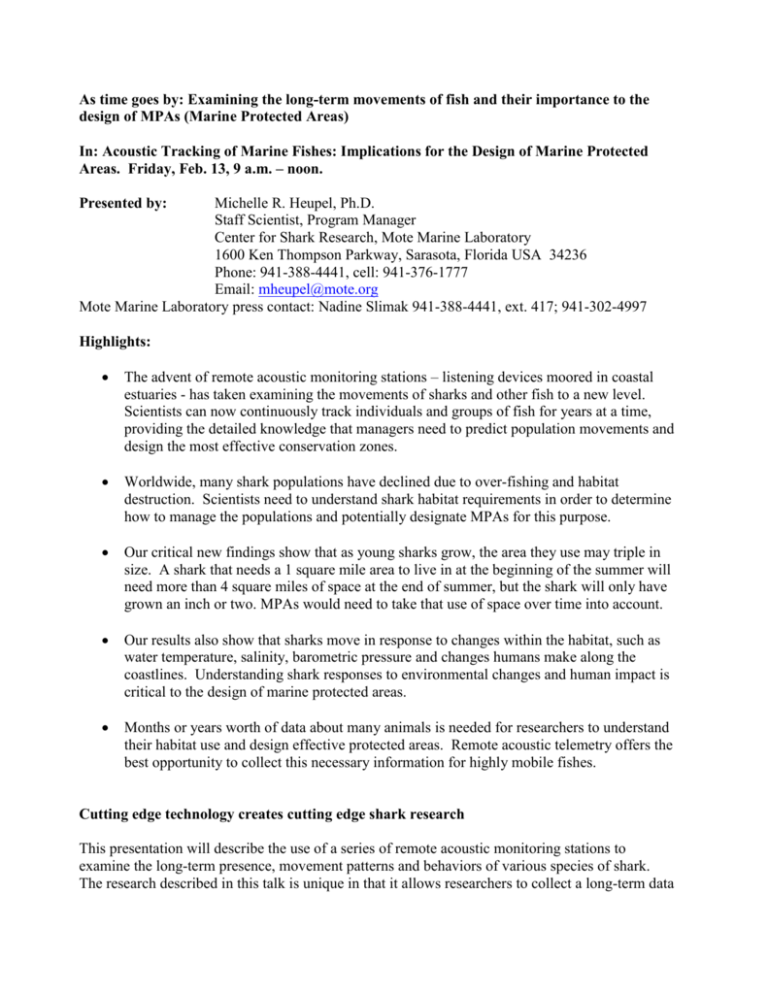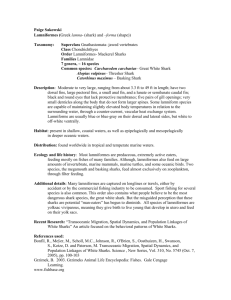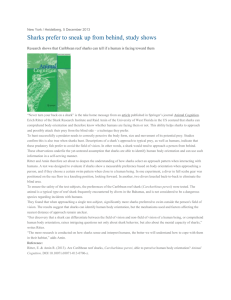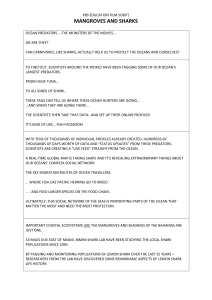As time goes by: examining the long-term movements
advertisement

As time goes by: Examining the long-term movements of fish and their importance to the design of MPAs (Marine Protected Areas) In: Acoustic Tracking of Marine Fishes: Implications for the Design of Marine Protected Areas. Friday, Feb. 13, 9 a.m. – noon. Presented by: Michelle R. Heupel, Ph.D. Staff Scientist, Program Manager Center for Shark Research, Mote Marine Laboratory 1600 Ken Thompson Parkway, Sarasota, Florida USA 34236 Phone: 941-388-4441, cell: 941-376-1777 Email: mheupel@mote.org Mote Marine Laboratory press contact: Nadine Slimak 941-388-4441, ext. 417; 941-302-4997 Highlights: The advent of remote acoustic monitoring stations – listening devices moored in coastal estuaries - has taken examining the movements of sharks and other fish to a new level. Scientists can now continuously track individuals and groups of fish for years at a time, providing the detailed knowledge that managers need to predict population movements and design the most effective conservation zones. Worldwide, many shark populations have declined due to over-fishing and habitat destruction. Scientists need to understand shark habitat requirements in order to determine how to manage the populations and potentially designate MPAs for this purpose. Our critical new findings show that as young sharks grow, the area they use may triple in size. A shark that needs a 1 square mile area to live in at the beginning of the summer will need more than 4 square miles of space at the end of summer, but the shark will only have grown an inch or two. MPAs would need to take that use of space over time into account. Our results also show that sharks move in response to changes within the habitat, such as water temperature, salinity, barometric pressure and changes humans make along the coastlines. Understanding shark responses to environmental changes and human impact is critical to the design of marine protected areas. Months or years worth of data about many animals is needed for researchers to understand their habitat use and design effective protected areas. Remote acoustic telemetry offers the best opportunity to collect this necessary information for highly mobile fishes. Cutting edge technology creates cutting edge shark research This presentation will describe the use of a series of remote acoustic monitoring stations to examine the long-term presence, movement patterns and behaviors of various species of shark. The research described in this talk is unique in that it allows researchers to collect a long-term data set for an individual animal since continuous data are collected. The data sets to be discussed encompass the entire summer of a sharks’ life within a specific habitat. These data are vital to a complete understanding of habitat use and MPA design for these mobile animals. Where we started These studies focused on several species of shark in the Gulf of Mexico, including the blacktip (heavily targeted by the commercial shark fishery), the bonnethead (the smallest member of the hammerhead family and a common coastal resident in Florida) and the bull shark (the only species of shark known to use freshwater habitats). We tagged more than 233 sharks with acoustic transmitters and moored acoustic hydrophones in the bays. When a tagged shark swims within about a half a mile of the receiver, it registers on the hydrophone. A computer chip inside the hydrophone records the date, time and identity of the fish. Why this is different The use of acoustic transmitters to track the movements of individual fish is not a new concept and is a technique that has been used for decades. But new less expensive and more compact technology is helping expand the study of fish movements and take the research to the next level. By deploying receivers so that their listening ranges overlap, we’ve been able to continuously monitor a group of animals and can tell with reasonable accuracy where they are within the study site. We’ve been able to monitor individual animals for months at a time and can examine seasonal differences in habitat use, home range size and movement patterns. Long-term monitoring can also help determine what causes fish to change their home range, such as growth or maturity, or as a response to changes in the environment such as water temperature, salinity level, etc. The study Our hydrophones were placed in three study sites on the central Gulf of Mexico coast of Florida. Shark movements were monitored for six months or more to learn about their long-term movement patterns in their summer habitats (most shark species migrate south from the central Gulf coast for the winter months). The results The home range size of young sharks changes over the course of a summer Within the first summer of their life young blacktip sharks can more than triple their home range size. This expansion is attributed to their growth. A slight increase in size coupled with experience capturing food and avoiding predators may give young sharks the confidence they need to explore new areas and increase the amount of area they cover. As the environment changed, habitat use changed In 2001, Tropical Storm Gabrielle made landfall on the southwest Gulf coast. Sharks started moving to Tampa Bay’s deeper waters from the study site about six hours before the storm arrived. It appears that sharks responded to the change in barometric pressure that accompanied the storm’s approach and fled the nursery area. We could only assume that this was a preservation response. All monitored sharks returned to the nursery area within two weeks. These data provide the first scientific support for anecdotal evidence provided by seasoned fishermen who have seen fish change habits with the weather and “go off the bite.” On a less dramatic note, bonnethead and bull sharks also appear to change their habitat use when environmental conditions change. Bonnethead sharks in Charlotte Harbor, south of Tampa Bay, abandoned their normal home ranges and moved out of the study site (and so used a larger area) when heavy rainfall caused salinity levels to decrease dramatically. All of the bonnethead sharks eventually returned when salinity levels returned to normal levels. In a similar but opposite reaction, when salinity levels decreased, newborn bull sharks used only a small part of the available area. When the environment was predominantly freshwater the sharks would not move beyond a two mile area near the river mouth, but once rainfall decreased and salinity increased, the young sharks moved all the way up the river, a distance of more than 30 miles. Human impacts (urbanization and damming of rivers) can have a dramatic effect on the amount of fresh water flowing in rivers and the subsequent salinity level of coastal estuaries and can change the behavior of animals that inhabit those regions. What this means for MPAs Sampling home range size in Tampa Bay early in the season for the purpose of defining an MPA would lead to a very restricted protection zone that sharks only stay within for a couple of months before expanding their home range beyond the boundaries of the designated area. Therefore, longterm data from multiple individuals may be critical to understanding how to design an adequate MPA for highly mobile fish species. Similarly, only examining home range sizes of newborn bull sharks in the period when they were using a small portion of the habitat would mislead researchers and managers into thinking these animals do not move outside that region, when in fact they can and do move much farther. These results suggest that even one year of data may not be enough to define a home range and design an MPA if we do not understand the factors affecting habitat use and movement patterns.







